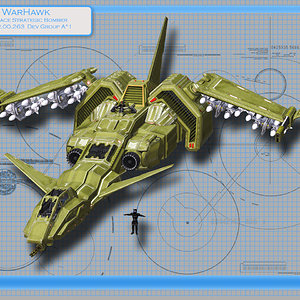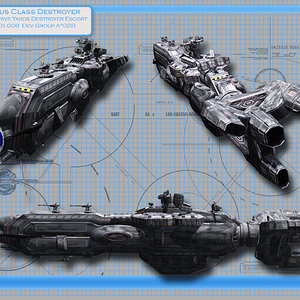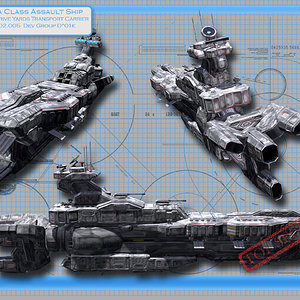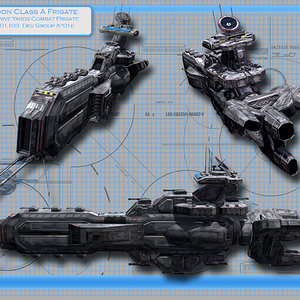ARMAMENT:
4 Turrets of Twin 145 mm (Approx. 6 Inch) Extended Range Stabilized Cannons
40+(Approx.) Dual 88 mm Anti-Aircraft Turrets
4 Twin by 6 Surface to Air Anti-Fighter Guided Missile Batteries
Undisclosed Combat A.P.U.s
COMPLIMENT:
145 Officers, Crew, and Gunnery personnel operating in three shifts, plus 4 full platoons (100 men) of Colonial Marines as ships security. Troop Transport Capacity for 4 full Companies, including support staff and vehicles with some room to spare (about 500 men).
The Iwo Jima's interior is broken into Multiple distinct sections - the Crew and Officer areas, and the Troop billets for each platoon. The Crew and officer areas are what one might expect of a combat vessel - cramped, ugly, noisy, and very grey. The Crew are assigned two in a room, in bunked billets resembling a college dorm room. Each room has a single closet that must be shared, and enough space for each crew member to also have a single foot locker of personal items and belongings. Each room also has a single wash closet which is shared. The overall layout of the State rooms are like dormitory blocks, with a number of rooms in each block sharing public showers and a physical recreation room. A single large cafeteria on each deck serves all of the blocks on a given deck, and doubles as the recreation room or social room when not serving meals. The officers quarters are larger, with independent, private lavatories. There is also a separate Officers mess, recreation room, and small weight room. The billets of the on-board marines is much different, with the marines being housed in large group rooms more reminiscent of a cargo bay lined with double-decker bunks. Each such bay houses 10 men, with each man being alloted a single footlocker of space for personal effects. Each of these bays also has a group lavatory and shower, as well as a weight training space and lockers and equipment racks at the far ends. The marines weapons are stored in Weapons lockers in the bays, with the officers and Non-commissioned Officers having proper clearance codes to access for rapid deployment if necessary. The second section of the vessel, housing the troops being transported, is designed and laid out into several "Barracks" that are directly attached to nearby Armory and Launch Bays for rapid landing and deployment of forces. These "Barracks" are not much different from those used by onboard security marines, only larger, with each housing a full platoon of troops, and a total of sixteen of these Gymnasium like rooms. Unlike the smaller rooms, movable privacy walls are used to open up or close off sections of each of these bays to allow some privacy between squads, or created areas for work and study for officers. These bays attach directly to group lavatory and showers for each bay, and from those the Armory and Gear Lockers, and then access locks to the launch bays. For Each of these bays there are 2 exits each leading to a Shower, Locker room, armory combination and then directly to a Launch bay typically housing a Skybus class launch. The Iwo Jima has 16 such launch bays, 8 Port and 8 Starboard, with each Skybus carrying half a platoon of infantry. The Vessel also maintains a PX and Commissary on the primary cargo and munitions deck that is accessible to all crew. An Iwo Jima class Transport maintains numerous launch bays for troop landing craft, as well as a primary flight bay that services many launches, shuttles, and landing craft (Typically 2 shuttles and 4 to 6 launches/Landing craft) for the purposes of cargo and personnel loading and unloading. On average an Iwo Jima Transport also maintains a compliment of nearly 2 dozen Utility A.P.U.s for maintenance, repair, and cargo handling. Each Iwo Jima class transport maintains it's own compliment of around a two dozen combat A.P.U.s for close support operations, defense, and boarding, in addition to any Combat A.P.U.s assigned to platoons in transit.
HISTORY:
The Iwo Jima Class was conceived during the height of the Corporate Insurrections, when fighting in space and planet side was at it's heaviest. Harsh combat conditions against the well equiped and trained corporate militias had demonstrated flaws in design and application of the earlier Utah Transport, which was built and conceived to deliver troops to a ground war. A need for better armor, better defensive and offensive weaponry, and the ability to deploy troops much more rapidly was needed. The Iwo Jima class, named after a famous desperate marine battle from wars of Old Earth Past, was the E.O.C. answer to these needs. The first of the Iwo Jima class series entered service at near the end of the Corporate Insurrections, and functionally changed the shape of the war. With it's enhanced comms and sensor array the Iwo Jima became not just a troop transport, but a viable mobile strategic H.Q. for the companies of troops assigned to it. The superior firepower of the Iwo Jima's anti-fighter defenses made it a lethal target to assault with small craft, and it's 145mm guns gave it the punch of a Corvette, which allowed it to defend itself against capital ships who managed to break the picket lines and close on the transports. The Iwo Jima was essentially a floating Space Bunker, that after deploying it's troops, could deliver pinpoint fire support, or move to support fleet operations. All of these factors were designed to allow the Iwo Jima to deliver troops in the front lines of an orbital assault and provide it a chance to survive.
In addition to it's significantly hardened defense and weapons, and upgraded sensors and comms, the Iwo Jima featured many more small launch bays than previous transports. In addition to it's Dual, Twin Decked foreward flight bays for large troop craft and supply vessels, the Iwo Jima features 16 single craft launch bays (8 port and 8 starboard) designed for small troop dropships (actually designed with the Skybus series of transport in mind). Each of these is directly linked to the Billets onboard housing a marine Platoon. In theory, with these alone, the Iwo Jima can deploy all 16 platoons simultaneously, while using the foreward bays to deploy combat A.P.U.s or support craft. Additionally the Iwo Jima class features 6 multi-purpose bays (3 Port, and 3 Starboard) that can be rigged and converted for flight bays, or ground deployment of vehicles and armor. Most Commonly the 6 multi-purpose bays are used for the housing and deployment of ground combat A.P.E.s (also known as Dreadnoughts), A.P.C.s, and Artillery support vehicles. It has been reflected by some on the ground that when an Iwo Jima class drops it's forces, it is like a wave of falling stars.
One of the most noticeable added capabilities of the Iwo Jima class ships over their predecessor the Utah class is the addition of powerful directional thrusters that allow the Iwo Jima to actually enter atmosphere. The Iwo Jima was designed to be able to execute aquatic landings and take offs under gravity conditions of up to 1.5 Gs. The Iwo Jima class is also fully capable of maintaining sustained positional hovering in a gravity well of up to 1.3 G's. This allows the Iwo Jima to serve not only as a troop deployment vehicle for planetary assault, but as a Forward Operation Base either in the air, or from an aquatic location. The intent is for an Iwo Jima to enter planetary Atmosphere in a combat theatre once ground to air threats have been eliminated and provide support during the secondary stages of a planetary invasion - giving deployed forces a mans of resuply and redeployment throughout the theatre as necessary. In theory, when operating in this capacity, Marine Artemis Class gunships would provide cover and fire support.
The Iwo Jima class is still relatively new to the services, and has not established any notable combat history thus far, but the Department of Defense has high hopes for this design.
CREDITS: Davorama (a.k.a Davo, Beyondbent, Powerfusion3D, PoserFusion3D), All the great Kitbashers who have posted images of assemblies with Davo's sets that inspired me.








